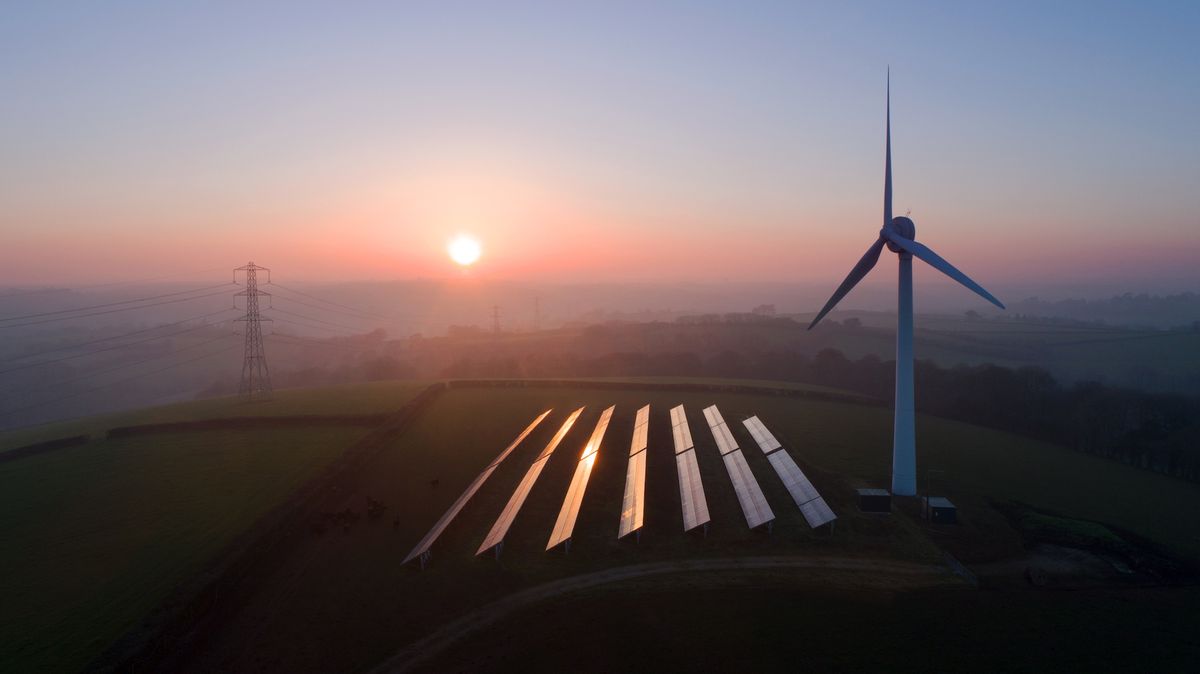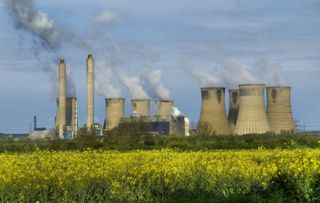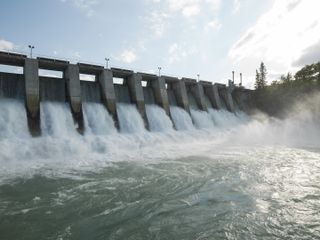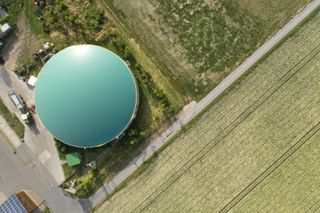What is renewable energy?
Is renewable energy better than "dirty" fossil fuels?

Renewable energy comes from sources that are replenished naturally, such as the sun and wind. Traditional energy sources, like coal and oil, are finite and when burned, release carbon in the form of carbon dioxide and methane — two greenhouse gases that significantly contribute to the acceleration of global climate change. Renewable energy, on the other hand, either does not emit carbon or is carbon neutral, meaning it absorbs as much carbon as it emits.
Related: US could reach 'net zero' carbon by 2050. Here's how.
Why is renewable energy important?
Tapping into sources of renewable energy is a relatively new development in the history of human energy production. Early human ancestors used wood to generate heat energy, then switched to coal, a fuel with higher energy density, as summarized in the textbook "The Cambridge World History" (Cambridge University Press, 2015). Petroleum oil now fuels the majority of the world's transportation industry, including cars, airplanes, boats and trains, according to the U.S. Energy Information Administration (EIA).
Coal, oil and natural gas are called "fossil fuels" because the products are formed over the course of millennia as heat and pressure transformed the fossilized remains of dead plants and animals trapped underground, according to the Geological Survey Ireland.
Burning fossil fuels, such as in power plants or cars, releases the carbon that had been trapped underground into the atmosphere. Humanity's dependence on fossil fuels is a leading cause of climate change because of the large amounts of carbon that fossil fuels dump into the atmosphere as they burn.
Related: The human fossil-fuel addiction: Greenhouse emissions soar to record levels
Not only are fossil fuels accelerating global climate change, but the supply is limited, so they're not a sustainable source of energy. Industries, countries and individuals around the world are now turning to renewable energy sources, which either do not produce carbon to generate energy or are carbon neutral, to minimize humanity's contribution to climate change and help make sure our planet has energy for the future.

Types of renewable energy
Here are some of the most common sources of renewable energy, and some concerns about them:
Solar
Solar energy involves converting the sun's radiation into trapped heat, then using that heat to create or sustain a chemical reaction, or generate electricity, according to Encyclopaedia Britannica. This can be achieved with photovoltaic solar panels or by concentrating solar-thermal power, which enables solar-generated heat to be stored until energy is needed.
Although solar energy is free, it's not always available — the sun doesn't shine at night, which often coincides with peak energy demand, according to the University of Calgary. For this reason, the fate of renewable energies such as solar and wind relies on the development of efficient battery storage.
Related: Solar power stations in space could be the answer to our energy needs
There are also environmental concerns about solar energy because some of the chemicals used to manufacture solar panels are toxic to the environment, according to the EIA. The agency's website states that "some solar thermal systems use potentially hazardous fluids to transfer heat. Leaks of these materials could be harmful to the environment."
Wind
Wind turbines are giant windmills with huge blades that get pushed around by the wind. As the blades rotate they spin a generator, which creates electricity. However, environmental groups and scientists are concerned about the impact of wind turbines on local bird and bat populations.
According to a 2015 review published in the journal Renewable and Sustainable Energy Reviews, wind turbines kill bats and birds when they fly into the turbine's enormous blades. A 2013 review published in the journal Renewable Energy estimated that wind turbines killed an estimated 20,000 birds in the United States in 2009, while fossil-fuel power stations killed about 14 million birds that year.
Related: How do wind turbines kill birds?
Electricity production from wind is also not 100% reliable because it depends on whether or not the wind is blowing, and even in the windiest areas there can be wind lulls.
Hydropower
There are a number of ways in which water can be used to create energy. For example, energy can be generated via the free-flow of water in a river or stream, or from water released out of a dam with a higher elevation, according to the U.S. Geological Survey. As the water flows, it turns turbines that generate electricity. Pumped storage is another method of hydropower that involves pumping water into a dam at a higher altitude during off-peak periods and then releasing it to transfer energy to the electricity grid when there is high demand.
Large dams and reservoirs, however, come with environmental concerns of their own, as these large-scale pieces of infrastructure drastically change water flow and affect local ecosystems, according to American Rivers, a nonprofit organization promoting river conservation. For example, the Itaipu Dam, a hydroelectric dam across the Paraná River between Paraguay and Brazil, was constructed in the 1970s and 1980s and has resulted in a 70% loss of biodiversity in the surrounding river habitat, Michigan State University professor Emilio Moran told the German news agency Deutsche Welle in June 2020.
But what about the largest body of water on our planet? Although the ocean contains an abundance of wave power, locating and building an efficient power station in the unforgiving saltwater environment presents huge logistical and financial challenges. Nonetheless, researchers and engineers are developing and testing new energy-capture systems with the goal of finding an efficient way to harness the energy of ocean waves, according to the U.S. Department of Energy.

Geothermal
There are two main methods of tapping into the energy below the Earth's surface.
One method, known as a geothermal heat pump, is used to heat or cool homes and other buildings. This system works by taking advantage of temperatures just a few feet underground where it's a relatively stable 50 to 60 degrees Fahrenheit (10 to 16 degrees Celsius), according to the Environmental and Energy Study Institute. Water-filled pipes are buried between 30 to 100 feet (9 to 30 meters) below ground and are connected to a surface-level pump that circulates the water through the pipes. In cold weather climates, as water is pumped through the warmer pipes in the ground to the cooler pipes in the house, it releases energy in the form of heat, which dissipates into the building, warming it up. Nine out of 10 houses in Iceland heat their houses using this method, according to Iceland's National Energy Authority. Geothermal heat pumps can also be used to help cool buildings down in warmer climates where the below-ground temperature is cooler than the air temperature.
Related: Magma power: Scientists drill into volcano to harness its energy
Further below Earth's surface are reservoirs of scalding water under extreme pressure from the tons of rock above. Another method of geothermal energy generation uses deep wells to access this water. As the hot water rises to the surface (driven by the pressure decrease) it turns to steam that creates enough force to turn the turbines of a powerstation, similar to the mechanism of a coal-fired powerstation. These deep geothermal vents produce substantially less toxic gas and 99% less carbon emissions than coal-fired power stations, according to the EIA.
Biofuel
The Environmental and Energy Study Institute, a nonprofit organization promoting sustainable energy, defines biomass as "living or recently dead organisms and any byproducts of those organisms, plant or animal. The term is generally understood to exclude coal, oil and other fossilized remnants of organisms, as well as soils." These biomass products absorb energy and carbon during their lifetime and are then burned for fuel, similar to fossil fuels, or converted into liquid fuel.
Related: Are biofuels worse than gasoline for the climate?
Biofuel, or energy created from burning biomass, is one of the more controversial renewable energy options because of its dependence on farms, forests and other ecosystems as sources of biomass. The largest agricultural biofuel industries, for example, turn crops such as sugar cane and soybeans into energy rather than selling the crops as food. But agriculture is a carbon-intense industry, which means those biofuels aren't exactly environmentally friendly. Using food crops for biofuel also threatens food security as biofuel crops affect the price and availability of food crops, according to a 2010 NATO report.

Is renewable energy cheaper or more expensive than traditional forms of energy?
In the first quarter of 2020, renewables accounted for 28% of global electricity generation, according to the International Energy Agency, an autonomous intergovernmental organization. Coal and gas, however, remain the global mainstays, representing 60% of global electricity supply.
A major impediment to the uptake of renewable energy has been its price tag, but as these technologies mature, their costs have decreased significantly. Between 2010 and 2019, the cost of solar panel technology dropped 82%, followed by concentrating solar power at 47%, onshore wind at 40% and offshore wind at 29%, according to the International Renewable Energy Agency (IRENA), an intergovernmental organization.
More than half of the renewable capacity added in 2019 achieved lower electricity costs than new coal generation, and new solar and wind projects are undercutting the cheapest of existing coal-fired plants, according to IRENA's 2019 report.
Can renewable energy sources replace fossil fuels?
Considering how heavily humanity still depends on fossil fuels, will sources of renewable energy ever replace them?
"The simple answer is 'yes,'" said Tomas Kåberger, a technology management and economics expert and affiliated professor at Chalmers University in Sweden. The major reason is that industrial technology development has pushed down the price of renewables, particularly wind and solar, allowing them to compete with fossil fuels, Kåberger said. Commercial advances in efficient battery technology, driven by cellphones, laptops and automotive manufacturers, has also led to cost decreases.
Related: This new cellphone uses such little power it doesn't need a battery
We may see a big shift in the next 10 years from fossil fuels to renewable energy, particularly in the electricity generation and transportation industries, said Ken Gillingham, an associate professor of energy economics at Yale University. But in order to accelerate the process, he said, the world needs policy interventions, such as carbon taxes or shifting government subsidies towards energy storage rather than generation.
Without government intervention, "we would get continual uptake of renewable energy over the next decade," Gillingham said, "but it won't, on its own, take us to the level we need to fully decarbonise electricity."
Additional resources:
- Learn how to conserve energy in your home with tips from the U.S. Department of Energy.
- Watch a video explainer about hydropower from the National Renewable Energy Laboratory.
- Learn more about geothermal energy from the Office of Energy Efficiency and Renewable Energy.
Sign up for the Live Science daily newsletter now
Get the world’s most fascinating discoveries delivered straight to your inbox.
Sarah Wild is a science journalist and a regular contributor to Live Science and Space.com. She is the author of "Searching African Skies: The Square Kilometre Array", "Innovation: Shaping South Africa through Science" and "South Africa's Quest to Hear the Songs of the Stars." Wild was the winner of the Siemens pan-African Profile Awards for science journalism in 2013 and received the Dow Technology and Innovation Reporting award in 2015.












